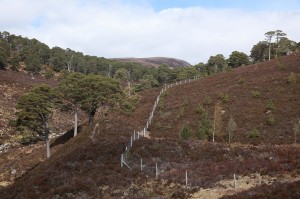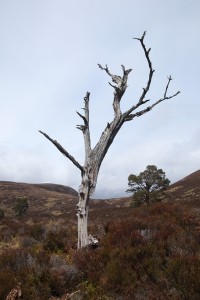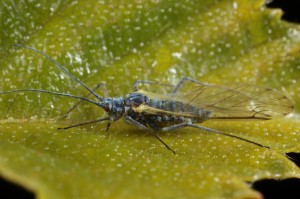
Having walked through part of the Liatrie Wood in Glen Cannich for the first time in many years during my Treelay leg on 7th and 8th May, I decided to spend a day there the following week-end. I had only seen a small part of the wood during the Treelay, and I hadn’t had an opportunity to go inside the exclosure that was fenced there for natural regeneration of the trees, so I was keen to explore the area in more detail.

It was a sunnier day than when I had been there on the Treelay, so I took a similar photograph to my visit on 8th May, showing the western edge of the regeneration fence. This was put up by the then Nature Conservancy Council in 1990, after I had approached them for advice about how to get a new generation of trees growing there. The contrast between the inside and outside of the exclosure is quite dramatic now, with no new trees outwith the fence, but lots of young pines and birches getting away inside.

All the old Scots pines in Liatrie Wood are coming to the end of their lives, and there are a lot of standing dead trees, or snags, scattered throughout the woodland. It was particularly poignant therefore to see lots of young trees growing up around some of the snags inside the exclosure – it is literally achieving the re-birth of this dying patch of forest.



Liatrie Wood is one of the most dramatic examples I’ve seen of the contrasting fates facing the old Caledonian Forest remnants – regeneration by reducing overgrazing by deer, or a continued decline and slow death of this ancient ecosystem.


Unlike during my fleeting visit whilst taking part in the Treelay, this time I crossed the fence and spent quite a while inside the regeneration exclosure. It was wonderful to see the new growth of both Scots pines and birches taking place there, and as if to confirm the significance of that, two separate passing brief showers each produced a rainbow whilst I was inside the fence!

Close examination of some of the birches revealed that, like those on Dundreggan and in Glen Affric that I’ve seen this spring, they were teeming with aphids. These are a species (Euceraphis punctipennis) that is especially abundant this spring, not only up here in the areas of the Highlands that I go to, but also, according to Ed Baker, the aphid specialist who will do a survey for us on Dundreggan in June, in other parts of the country as well.

Like other groups of insects, aphid populations go through cycles of lesser and greater abundance from year to year, for reasons that are not entirely understood, but that will be due at least in part to annual weather fluctuations. With my growing fascination with aphids, and the survey coming up at Dundreggan, it seems very timely therefore that there’s an abundance of at least one species this year!

While I was looking at the aphids on one of the birches, I noticed some galls on several of the leaves. These are quite distinctive and are induced by a tiny midge (Cecidophyopsis betulae) – I’ve seen them before on birches at Dundreggan and in Glen Affric. Seeing both the aphids and these galls gives an indication of the life that is benefitting from the growth of these new trees inside the fenced area at Liatrie. The aphids and gall mites are food for other species of insects, so the whole web of life is recovering in diversity and abundance as the new trees grow there.

However, it’s not just the trees that are benefitting. The forest understorey vegetation of blaeberry (Vaccinium myrtillus) and cowberry (Vaccinium vitis-idaea) is also growing healthily.


These plants were much larger inside the fence, and they were also flowering profusely, whereas outside they were all suppressed and I didn’t see any flowers at all.


The same is true of other non-woodland plants, such as bog myrtle (Myrica gale). This occurs in wet boggy areas, where trees normally don’t grow, but is another favourite food of red deer (Cervus elaphus), so outside of protected areas it too is heavily overgrazed and stunted. Inside the exclosure it was substantially larger in size and was flowering in abundance, adding to the recovery of the vegetation communities there. It supports a number of species of insects, including the Argent & Sable moth (Rheumaptera hastata), which is a priority for conservation under the UK’s Biodiversity Action Plan (BAP), so its recovery here will provide increased habitat for the moth.


I spent much of the day inside the exclosure, and it was only late on that I left it and crossed the burn, to where the main part of Liatrie Wood is. It consists of large numbers of Scots pines that grew up closely together, so they have straight trunks with very few low branches on them. The understorey vegetation is heavily suppressed by all the deer that have access to the woodland, and there’s no young trees getting established whatsoever.

I headed down the hill, and as I got to the edge of the woodland, the sky darkened and a lone dead pine was silhouetted against the approaching clouds. This tree is the southwestern-most outlier of Liatrie Wood, and its fate, and what it portends for the unprotected area of old pines there, seemed to be amplified by the approaching rain clouds. It provided a sobering end to the day, and a stark reminder of how much still needs to be done to save some of the ancient Caledonian Forest remnants before they disappear.
Is this the same burn they are putting hydro in at the moment just been looking at the survey 2015 they did of wild life in the area
Hi Carole,
Yes, there’s a hydro scheme going in that burn just now. There are apparently plans also to do some more protection of another part of the wood, but I don’t know what the details of that are.
With best wishes,
Alan
Brilliant blog again, Alan! I did enjoy how passing it in the treelay made you go back, we had a brilliant time on our leg finding patches of cordoned off and regenerating forest. Do you think the treelay could become an annual event? It’s certainly raised awareness of TfL among my friends, several of whom have said that they’d be very interested in taking part in future years.
These photos are very evocative though. The ones taken outside the enclosure where you see the dead, and the soon to be dead trees, are very harrowing. Hits hard.
Hi Heather, Thanks for your comment, and I’m glad you’re enjoying my blogs, and that you had a great experience on your Treelay leg. Many thanks for supporting us by taking part in it. We haven’t thought about any similar events in future, but now that you mention it, we’ll give it some consideration … With best wishes, Alan.
Another nice write-up Alan. Great mix of closeups and landscapes. :o)
Thanks Rob. I’m glad you’re continuing to enjoy the blogs. With best wishes, Alan.
The first photos give such dramatic visual evidence of the positive impact of fencing for encouraging regeneration of the forest – brilliant, Alan! As a novice at identifying flora and insects, the photos and text you share are great for me. The final photo is so evocative.
Hi David, Thanks for your comment. You must have read the blog just after I posted it, as I’m still doing some editing on it – adding links and correcting one or two typos! With best wishes, Alan